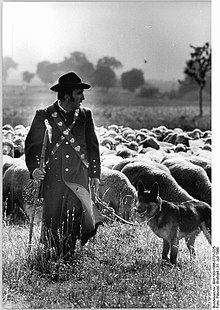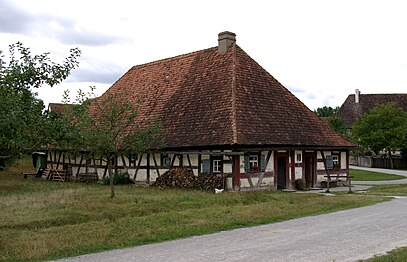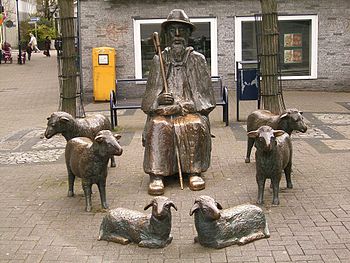Sheep farm
Commercial sheep farming includes the care, breeding and utilization ( milk , meat , wool , leather ) of sheep . The training occupation of the shepherd (outdated: shepherd) has the official designation animal host , specializing in sheep farming . Before training, you only complete a year of vocational primary school (BGJ) in Bavaria . The training lasts three years with a final exam. There is then the opportunity to take the master craftsman examination .
shepherd
Sheep are mostly kept in flocks , which a shepherd looks after with the help of shepherds or herding dogs . It is typical that the shepherd leads his herd ' nomadic ' through open, generally accessible land (wandering shepherd), while other cattle are usually in the stable or on the pasture that belongs to the farmer. A distinction is made between herding and coupled sheep farming.
The shepherd's profession is not limited to producing sheep meat and lamb's wool. The prices of sheep meat and wool have fallen significantly in recent years. A shepherd is also a landscape manager, because the landscapes that are not grazed by sheep would otherwise be overgrown with trees and bushes within a short time. The European Union provides funds for the activity as landscape maintenance.
The shepherd's job in his specific job is to find feeding places, to keep the herd together and to protect it from danger. In the past, some shepherds stayed overnight in small wooden shepherd carts right next to their flock. A traditional tool is the shepherd's shovel .
Duties of the shepherd

One of the duties of a shepherd is
- Lambing and rearing animals, including knowledge of the anatomy, physiology, breeding, racial studies and reproduction of sheep;
- Knowledge about pasture management and fodder production;
- Mastery of sheep farming in general, including stable construction , pen technology , hygiene measures and knowledge of animal diseases;
- Herding technology with the herd dog and its training as well as wolf defense ;
- the production of wool, meat and milk and the marketing of these products. That is why he should also be able to slaughter his sheep in accordance with animal welfare standards .
history
Sheep is one of the oldest trades in the world. The domestication of the sheep began 10,000 years ago in Asia Minor and from there it has spread across Asia and Europe . In the past, sheep farming was considered a dishonest profession . Today it plays a rather subordinate role in agriculture in Europe, while it is still practiced as a subsistence economy , especially in Asia and Africa .
Recent history using the example of the Rhön
Various forms of sheep farming have come down to us from old files from the bishopric of Fulda , especially from the 18th century:
- Shepherds were referred to as hereditary sheep farms, in which mostly larger land holdings, sealed by an award document, passed into the possession of the shepherd. Mostly manors were considered with it and it was the rarer variant.
- An early form of cooperative was named as lass sheep . The comrades had no claim to ownership of the areas and had to apply for their use every year. The rulers stipulated the lambs to be given and on which hats the comrades were allowed to keep a specified number of sheep.
- Another form was meanness . This was understood to mean areas in communal ownership for joint paddock or herding. The right of use was often shared by several communities and can be traced back to the common mark . This meanness ( common land ) was only dissolved in the Rhön in the 1870s.
At the beginning of the 20th century, sheep were mainly kept in community, cooperative and in some areas traveling sheep farms. In 1913 there were 56 community sheep farms and 256 cooperative herds in Hessen-Nassau .
Sheep farming in the GDR
In the GDR were sheep primarily for wool production held. In this way foreign currency for the import of sheep wool from Australia or New Zealand could be saved. This led to the build-up of 6,000 sheep herds with 2.65 million animals (entire Federal Republic of 2018: 1.6 million animals). 90% of the lamb was exported to the Federal Republic and the Arab region. Each LPG was obliged to keep a flock of sheep. Around 6,000 shepherds were employed in the GDR, and the young professionals were trained at a special shepherd school. After the fall of the Wall there was no longer any need to procure foreign currency and the sheep population fell significantly.
Shepherd and music
“A shepherd must also be able to play a wind instrument, not because of the old madness that the sheep should get fat more from the music than from grazing and feeding, but because the sheep (as experience confirms ) before other animals, especially those who love music: they love it immensely, and are thereby very lively. In addition, it is very convenient for the shepherd to be able to command his flock with the flute: as do the foreign shepherds who hold them together with certain bits on their bagpipes, call them to themselves, and drive them away again. "
statistics
In 2017, the Federal Association of Professional Shepherds in Germany counted 989 full-time shepherds and 1.1 million ewes, 0.6 million fewer than in 2001. According to the "Schafsreport Baden-Württemberg", the average wage was 6.15 euros per hour.
Other meanings
The special position of the shepherd's profession has found expression in Christian symbolism (the good shepherd , the lost sheep) and in the shepherd's poetry .
Many artists have quoted this symbolism in their work, for example Johann Georg Mohr with depictions of shepherds in the Taunus.
Shepherd's building from 1744 from Hambühl in the Franconian Open Air Museum Bad Windsheim
Shepherd group (bronze) in Mettmann
See also
- Pasture (grassland) and extensive animal husbandry
- Transhumance - seasonal migrant grazing
- Pastoralism - natural grazing
- Shepherd people - predominantly livestock, non-sedentary peoples
- Schäferlauf - traditional festival of the Württemberg shepherd's guild
literature
- Sheep farming. The magazine for sheep and goat farmers . Ulmer, Stuttgart, 2006–, ISSN 1862-0264 (1909–1980 under the title: Deutsche Schäfereizeitung , 1981–2005 Deutsche Schafzucht , ISSN 0720-0862 )
- Annette Arnold, René Reibetanz: Everything for the sheep. Handbook for appropriate husbandry . pala, Darmstadt 2008, ISBN 978-3-89566-236-2 .
- Carolin Eiberger: Organic sheep farming in Germany. Status quo and future prospects. Empirical investigation and economic evaluation . Logos, Berlin 2006, ISBN 978-3-8325-1394-8 ( dissertation at the University of Hohenheim 2006, 181 pages7).
- Wolfgang Jacobeit : Sheep farming and shepherds in Central Europe until the beginning of the 20th century . 2nd Edition. Akademie-Verlag, Berlin 1987, ISBN 3-05-000144-5 .
- Helmut Kühnemann: Sheep . 2nd Edition. Ulmer, Stuttgart 2007, ISBN 978-3-8001-5473-9 (= guide for farm animals ).
- Friedrich-Wilhelm A. Reckfort: Wandering Shepherd. Work and life, economy and social. Waxmann, Münster / New York, NY 1994, ISBN 3-89325-165-0 (Dissertation University of Münster 1992, 250 pages, under the title: Wandering sheep farming in the Westphalian region ).
- Wolfgang Schlolaut, Günter Wachendörfer: Handbook of sheep keeping . 5th edition. DLG-Verlag, Frankfurt am Main 1992 (including publishers), ISBN 3-7690-0492-2 .
- Julius Scholz: Shepherd's right according to common law and with special consideration for the laws of several German states. For lawyers and farmers . Vieweg, Braunschweig 1837 ( digitized version ).
- Iman Sharief: The Sheep Food Chain : Transfer of Zoonotic Pathogens from Animals to Food , Free University Berlin 2015 DNB 107315078X (Dissertation FU Berlin 2015, full text online , PDF, free of charge, 155 pages, 2.56 MB).
- Albrecht Thaer: Manual for the fine woolly sheep breeding . Maeckensche Buchhandlung, Reutlingen 1811 ( digitized version ).
Web links
- Bundesverband Berufsschäfer eV
- Association of German Sheep Breeding Associations (VDL)
- Shepherds must also be able to calculate
- Process of vocational training to become a shepherd (animal farmer - sheep farm)
- planet e. : Shepherd in need - a traditional job before the end (documentary, 28 min., 2019)
Individual evidence
- ↑ To the training of the shepherd on www.lfl.bayern.de . Retrieved December 28, 2010
- ↑ http://www.lfl.bayern.de/itz/schaf/28033/ Innovations in the shepherd training
- ↑ May / dpa: Profession: Sheep are looking for shepherds. In: Focus Online . April 7, 2007, accessed October 14, 2018 .
- ^ Theodor Hornberger: The shepherd . Verlag W. Kohlhammer, Stuttgart 1955, pp. 38-42.
- ↑ Hubert Beier: Investigations over 70 years of organized Rhön sheep breeding and the resulting conclusions for the future of this breed , Gießen, 1984, dissertation at the Justus Liebig University Gießen, pp. 21/22
- ↑ Hubert Beier: Investigations over 70 years of organized Rhön sheep breeding and the resulting conclusions for the future of this breed , Gießen, 1984, dissertation at the Justus Liebig University Gießen, pp. 22-25
- ↑ http://www.fao.org/faostat/en/#data/QA >, accessed on August 9, 2020
- ↑ The shepherd school on the website of the city of Wettin-Lobejün , accessed on August 9, 2020
- ↑ Annette Bruhns: The lost sheep . In: Der Spiegel . No. 33 , 2018, p. 52 f . ( online ).









